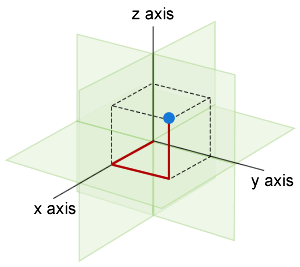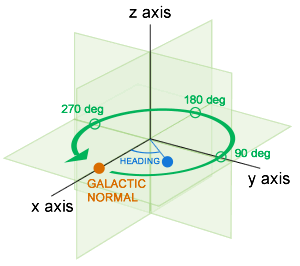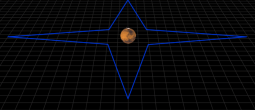

Vessel Position & Direction

The navigation system is based around Navigable Astronomical Objects (NAOs) – typically stars – whose position is fixed by stellar cartography.
Navigators can provide a heading and range which allows any NAO to be reached via superluminal travel from any other point in the mapped galaxy.
Once a NAO has been reached, the impulse navigation mode utilises a three-dimensional Cartesian grid for tracking the position of all objects in the surrounding space.
Positions are expressed as a triple set of co-ordinates representing the X, Y and Z axes of the grid. The grid is anchored on the NAO (at grid co-ordinates X0, Y0, Z0) and radiates from that point.
The grid does not have a predetermined size and grows as required by the direction and range of vessel travel.
 As the distances between NAOs would take several years to traverse at impulse speeds, the grids around any two NAO’s would never meet.
As the distances between NAOs would take several years to traverse at impulse speeds, the grids around any two NAO’s would never meet.
Galactic Normal
The network of NAOs is also used establish galactic normal, which is a universally constant reference point for establishing direction, much like magnetic north is used by compasses on Earth. The navigation systems are able to use whatever combination of NAOs are detectable from the vessel's current location to calculate galactic normal.
Heading
 The vessel’s direction of travel – or heading – is also managed by the navigation system. Headings are calculated against galactic normal, expressed as the number of degrees variation between travelling directly towards galactic normal (zero degrees) and the vessel’s actual direction of travel.
The vessel’s direction of travel – or heading – is also managed by the navigation system. Headings are calculated against galactic normal, expressed as the number of degrees variation between travelling directly towards galactic normal (zero degrees) and the vessel’s actual direction of travel.
If an object can maneuver (change direction under its own power) then it is considered a Tactically Significant Maneuvering Object (TSMO) and its heading is also managed by the navigation system.
Bearing
Vessel orientation is determined using bearings. A bearing describes a direction relative to the bow of the vessel (instead of relative to galactic normal). It is used to express the orientation of an object in surrounding space relative to the vessel. This is often a more intuitive way of expressing a TSMO’s relative position rather than its grid co-ordinates.
Range
Range determines distance along a bearing to an object. Range is an important factor in determining the effectiveness of sesnors and weapons, for example.








